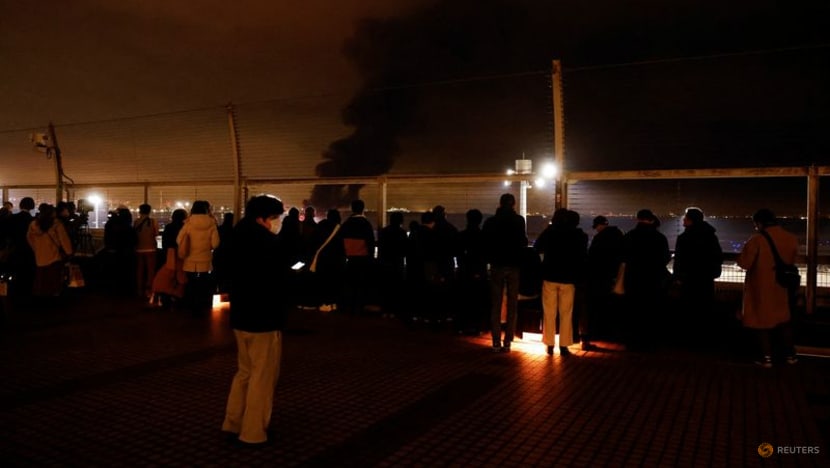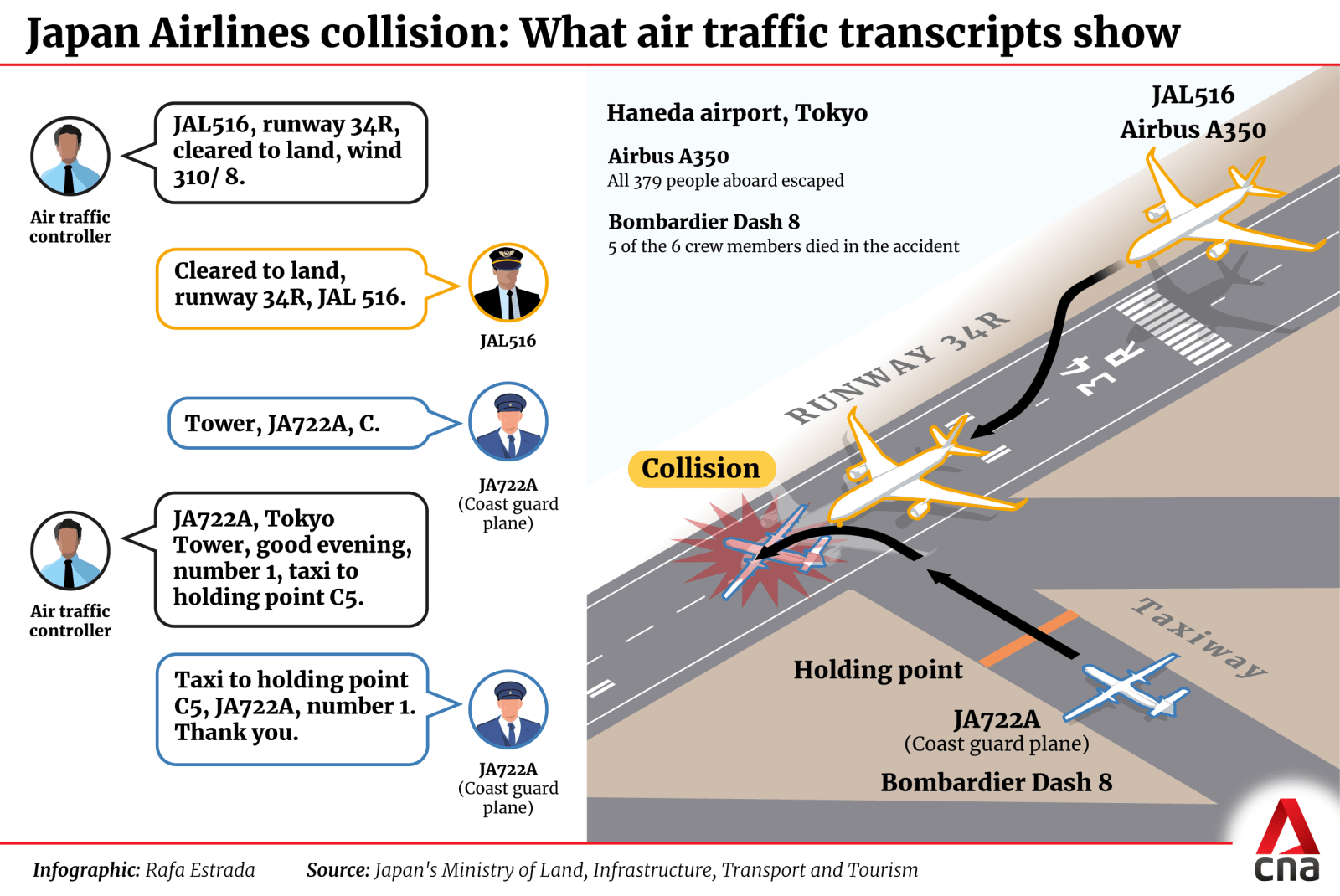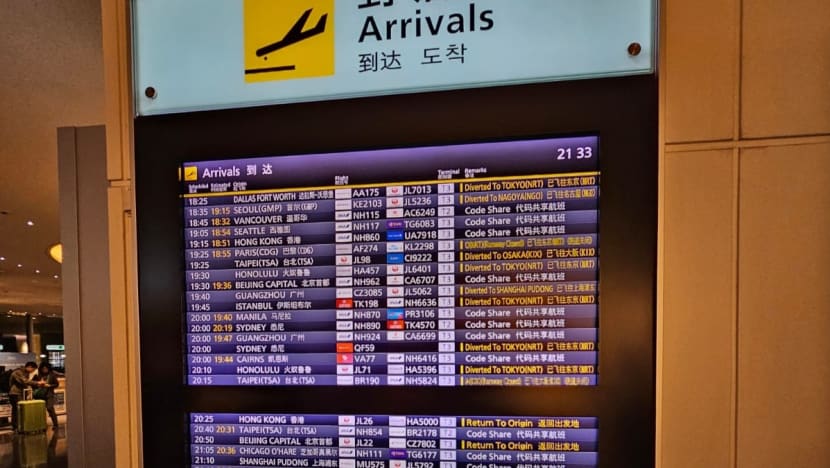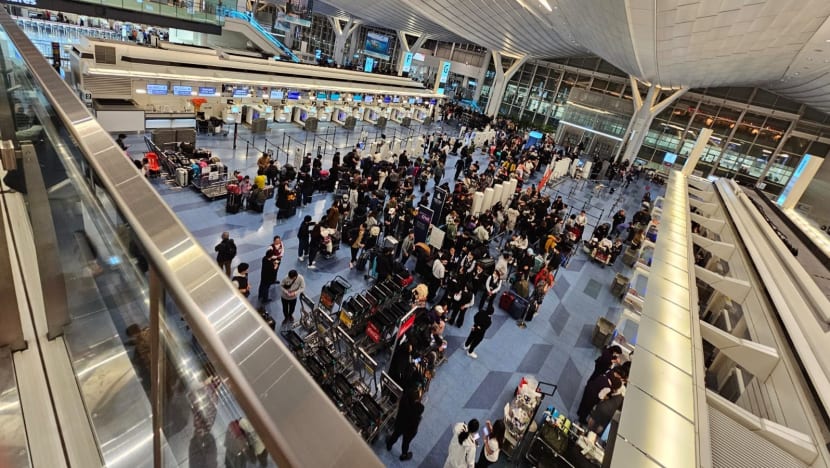‘We smelled burning rubber’: Singaporeans recount experience at Tokyo airport after Japan Airlines collision
Singaporeans who were at Haneda Airport tell CNA they were shocked by the incident, and felt relieved after touching down in Changi.

Passengers watch from an observation deck as Japan Airlines' A350 airplane burns at Haneda International Airport in Tokyo, Japan, on Jan 2, 2024. (Photo: Reuters/Issei Kato)

This audio is generated by an AI tool.
SINGAPORE: A family of four Singaporeans were at Tokyo's Haneda Airport on Tuesday night (Jan 2) to board their midnight flight back home after a holiday.
Upon reaching Terminal 2, where their flight was scheduled to take off, the Bay family were redirected to Terminal 3.
But not before they noticed a strange smell in the air.
“It was at T2 that we smelled the burning rubber. As well as when we were on the monorail (to go to T3),” said Mrs Bay, who declined to give her full name.
The smell was caused by raging fire on a runway, after a Japan Airlines (JAL) passenger jet and a Japanese Coast Guard plane were involved in a near-catastrophic collision.
All 379 passengers and crew on JAL flight 516 safely escaped down emergency slides just minutes before the plane was engulfed in flames. All but one of the six people on the Coast Guard aircraft died.
It took firefighters more than six hours to extinguish the fire, leaving a charred husk of the airliner on the tarmac.
The family said they did not manage to catch a glimpse of the incident, and only found out what happened through social media.
“When I saw the (scale of the incident) on Instagram, I was a little bit concerned that we were in the middle of a disaster zone,” Mrs Bay said.
They gave their account to CNA after touching down at Changi Airport on Wednesday morning, about one-and-a-half hours after the scheduled arrival time.
Another passenger on the same flight, Mr Brandon Lim, who was returning to Singapore from a holiday in Japan, watched the blaze from inside the safety of Terminal 3.
He used his phone camera to get a clearer picture of the inferno.
“We could see the fire engines trying to put out the fire from a distance. We needed to zoom in to see the incident area but the smoke was very visible. But people inside the terminals were not really affected by (the smoke). It was pretty safe inside the terminals,” he said.
He quickly updated his family back home about the incident and assured them he was safe – albeit delayed – at the airport.

DELAYS FOLLOWING INCIDENT
Immediately following the collision, all runways were closed at the airport, delaying flights and leaving thousands of travellers stranded.
Passengers in the airport were calm, but the atmosphere was grim, Mrs Bay said.

As more people arrived in the airport, there were snaking lines to purchase food and for mobile phone charging stations, she added.
“There was some anxiety because we had no idea if the delay was going to be days-long or hours-long,” said one passenger.
Mrs Bay said: “Later, when boarding was permitted, there were a lot of queues to check in and for security checks of hand luggage en masse. We had to stay together and try to explain in English to very stressed-out airport staff.”
Travellers also expressed grief over those affected in the collision, especially those in the Coast Guard jet who lost their lives.
“Although there were some delays, that did not really affect me too much and I was actually worried about the people on the (two) planes,” said Mr Lim.
A Japanese woman who arrived in Singapore for a holiday on a delayed flight initially wanted to share her thoughts with CNA. But overwhelmed by emotions, she later excused herself from the interview.
“Lives were lost in the incident. We felt very worried but it didn’t feel right to be upset about the flight delays when lives were lost,” said Ms Kristine Bay.
AIRPORT STAFF PRAISED
Worried about the flight delays, the Bay family went to the terminal’s observation deck and peered out into the dark, trying to assess the situation on the ground.
“We saw (airport authorities) manoeuvring planes to different runways. That was very assuring because we knew they were trying to move the air traffic along. And when we saw some planes take off, we knew that (the delay) would be fixed very soon,” said Mr Marvin Bay.

Like other passengers, they praised the efficiency of the Japanese in their management of the situation.
“Initially there was quite a long delay. The queues to departure were snaking and there were a few irate people,” said the Bay family.
“But we could tell that the Japanese were very focused on getting things running smoothly as fast as possible … and later caught up with the backlog.
“We managed to be only delayed by three hours. I would say this is typical Japanese efficiency. It was not easy on the whole airport staff. Huge props to the ground crew.”


















